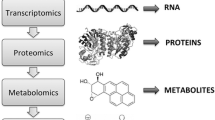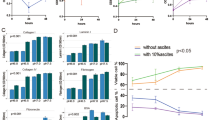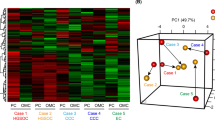Abstract
Introduction
Malignant ascites (MA) is a major cause of morbidity that occurs in 37% of ovarian cancer patients. The accumulation of MA in the peritoneal cavity due to cancer results in debilitating symptoms and extremely poor quality of life. There is an urgent unmet need to expand the understanding of MA to design effective treatment strategies, and to improve MA diagnosis.
Objective
Our purpose here is to contribute to a better characterization of MA metabolic composition in ovarian cancer.
Method
We determined the metabolic composition of ascitic fluids resulting from orthotopic growth of two ovarian cancer cell lines, the mouse ID8- vascular endothelial growth factor (VEGF)-Defb29 cell line and the human OVCAR3 cell line using high-resolution 1H MRS. ID8-VEGF-Defb29 tumors induce large volumes of ascites, while OVCAR3 tumors induce ascites less frequently and at smaller volumes. To better understand the factors driving the metabolic composition of the fluid, we characterized the metabolism of these ovarian cancer cells in culture by analyzing cell lysates and conditioned culture media with 1H NMR.
Results
Distinct metabolite patterns were detected in ascitic fluid collected from OVCAR3 and ID8-VEGF-Defb29 tumor bearing mice that were not reflected in the corresponding cell culture or conditioned medium.
Conclusion
High-resolution 1H NMR metabolic markers of MA can be used to improve characterization and diagnosis of MA. Metabolic characterization of MA can provide new insights into how MA fluid supports cancer cell growth and resistance to treatment, and has the potential to identify metabolic targeting strategies to reduce or eliminate the formation of MA.





Similar content being viewed by others

Abbreviations
- Chk:
-
Choline kinase
- Cho:
-
Free choline
- CSI:
-
Chemical shift imaging
- GPC:
-
Glycerophosphocholine
- PC:
-
Phosphocholine
- PtCho:
-
Phosphatidylcholine
- PUFA:
-
Poly unsaturated fatty acids
- tCho:
-
Total choline
- VEGF:
-
Vascular endothelial growth factor
References
Adosraku, R. K., Choi, G. T., Constantinou-Kokotos, V., Anderson, M. M., & Gibbons, W. A. (1994). NMR lipid profiles of cells, tissues, and body fluids: Proton NMR analysis of human erythrocyte lipids. Journal of Lipid Research, 35(11), 1925–1931.
Ahmed, N., & Stenvers, K. L. (2013). Getting to know ovarian cancer ascites: Opportunities for targeted therapy-based translational research. [Review]. Frontiers in Oncology, 3, 256. doi:10.3389/fonc.2013.00256.
Ammouri, L., & Prommer, E. E. (2010). Palliative treatment of malignant ascites: Profile of catumaxomab. Biologics, 4, 103–110.
Bala, L., Sharma, A., Yellapa, R. K., Roy, R., Choudhuri, G., & Khetrapal, C. L. (2008). H-1 NMR spectroscopy of ascitic fluid: Discrimination between malignant and benign ascites and comparison of the results with conventional methods. NMR in Biomedicine, 21(6), 606–614. doi:10.1002/nbm.1232.
Beckonert, O., Keun, H. C., Ebbels, T. M., Bundy, J., Holmes, E., Lindon, J. C., et al. (2007). Metabolic profiling, metabolomic and metabonomic procedures for NMR spectroscopy of urine, plasma, serum and tissue extracts. Nature Protocols, 2(11), 2692–2703. doi:10.1038/nprot.2007.376.
Bharti, S. K., & Roy, R. (2012). Quantitative 1H NMR spectroscopy. TrAC Trends in Analytical Chemistry, 35, 5–26.
Bharti, S. K., & Roy, R. (2014). Metabolite identification in NMR-based metabolomics. Current Metabolomics, 2, 163–173.
Conejo-Garcia, J. R., Benencia, F., Courreges, M. C., Kang, E., Mohamed-Hadley, A., Buckanovich, R. J., et al. (2004). Tumor-infiltrating dendritic cell precursors recruited by a beta-defensin contribute to vasculogenesis under the influence of Vegf-A. [Comparative Study, Research Support, Non-U.S. Gov’t, Research Support Gov’t, P.H.S.]. Nature Medicine, 10(9), 950–958. doi:10.1038/nm1097.
Cruz, T., Balayssac, S., Gilard, V., Martino, R., Vincent, C., Pariente, J., et al. (2014). 1H NMR Analysis of cerebrospinal fluid from Alzheimer’s disease patients: An example of a possible misinterpretation due to non-adjustment of pH. Metabolites, 4(1), 115–128. doi:10.3390/metabo4010115.
Gowda, G. A. N., & Raftery, D. (2014). Quantitating metabolites in protein precipitated serum using NMR spectroscopy. Analytical Chemistry, 86(11), 5433–5440. doi:10.1021/ac5005103.
Herr, D., Sallmann, A., Bekes, I., Konrad, R., Holzheu, I., Kreienberg, R., et al. (2012). VEGF induces ascites in ovarian cancer patients via increasing peritoneal permeability by downregulation of Claudin 5. Gynecologic Oncology, 127(1), 210–216. doi:10.1016/j.ygyno.2012.05.002.
Hilvo, M., de Santiago, I., Gopalacharyulu, P., Schmitt, W. D., Budczies, J., Kuhberg, M., et al. (2016). Accumulated metabolites of hydroxybutyric acid serve as diagnostic and prognostic biomarkers of ovarian high-grade serous carcinomas. Cancer Research, 76(4), 796–804. doi:10.1158/0008-5472.CAN-15-2298.
Kipps, E., Tan, D. S., & Kaye, S. B. (2013). Meeting the challenge of ascites in ovarian cancer: New avenues for therapy and research. [Research Support, Non-U.S. Gov’t]. Nature Reviews Cancer, 13(4), 273–282. doi:10.1038/nrc3432.
Kolomeyevskaya, N., Eng, K. H., Khan, A. N., Grzankowski, K. S., Singel, K. L., Moysich, K., et al. (2015). Cytokine profiling of ascites at primary surgery identifies an interaction of tumor necrosis factor-alpha and interleukin-6 in predicting reduced progression-free survival in epithelial ovarian cancer. [Research Support, N.I.H., Extramural]. Gynecologic Oncology, 138(2), 352–357. doi:10.1016/j.ygyno.2015.05.009.
Landskron, J., Helland, O., Torgersen, K. M., Aandahl, E. M., Gjertsen, B. T., Bjorge, L., et al. (2015). Activated regulatory and memory T-cells accumulate in malignant ascites from ovarian carcinoma patients. [Research Support, Non-U.S. Gov’t]. Cancer Immunology, Immunotherapy : CII, 64(3), 337–347. doi:10.1007/s00262-014-1636-6.
Lu, W. Q., Pelicano, H., & Huang, P. (2010). Cancer metabolism: Is glutamine sweeter than glucose? Cancer Cell, 18(3), 199–200. doi:10.1016/j.ccr.2010.08.017.
Masoumi Moghaddam, S., Amini, A., Morris, D. L., & Pourgholami, M. H. (2012). Significance of vascular endothelial growth factor in growth and peritoneal dissemination of ovarian cancer. [Review]. Cancer Metastasis Reviews, 31(1–2), 143–162. doi:10.1007/s10555-011-9337-5.
Odunsi, K., Wollman, R. M., Ambrosone, C. B., Hutson, A., McCann, S. E., Tammela, J., et al. (2005). Detection of epithelial ovarian cancer using 1H-NMR-based metabonomics. [Comparative Study, Research Support, Non-U.S. Gov’t, Research Support., Gov’t, U. S. P.H.S.]. International Journal of Cancer, 113(5), 782–788, doi:10.1002/ijc.20651.
Penet, M. F., Krishnamachary, B., Wildes, F., Mironchik, Y., Mezzanzanica, D., Podo, F., et al. (2016). Effect of pantethine on ovarian tumor progression and choline metabolism. Frontiers in Oncology, 6, 244. doi:10.3389/fonc.2016.00244.
Robinson-Smith, T. M., Isaacsohn, I., Mercer, C. A., Zhou, M., Van Rooijen, N., Husseinzadeh, N., et al. (2007). Macrophages mediate inflammation-enhanced metastasis of ovarian tumors in mice. [Research Support, Non-U.S. Gov’t]. Cancer Research, 67(12), 5708–5716. doi:10.1158/0008-5472.CAN-06-4375.
Serkova, N. J., & Brown, M. S. (2012). Quantitative analysis in magnetic resonance spectroscopy: From metabolic profiling to in vivo biomarkers. [Research Support, N.I.H., Extramural Research Support, Non-U.S. Gov’t Review]. Bioanalysis, 4(3), 321–341. doi:10.4155/bio.11.320.
Trape, J., Gurt, G., Franquesa, J., Montesinos, J., Arnau, A., Sala, M., et al. (2015). Diagnostic accuracy of tumor markers CYFRA21-1 and CA125 in the differential diagnosis of ascites. Anticancer Research, 35(10), 5655–5660.
Van, Q. N., Chmurny, G. N., & Veenstra, T. D. (2003). The depletion of protein signals in metabonomics analysis with the WET-CPMG pulse sequence. [Research Support., Gov’t, U. S. P.H.S.]. Biochemical and Biophysical Research Communications, 301(4), 952–959.
Vettukattil, R., Hetland, T. E., Florenes, V. A., Kaern, J., Davidson, B., & Bathen, T. F. (2013). Proton magnetic resonance metabolomic characterization of ovarian serous carcinoma effusions: Chemotherapy-related effects and comparison with malignant mesothelioma and breast carcinoma. Human Pathology, 44(9), 1859–1866. doi:10.1016/j.humpath.2013.02.009.
Acknowledgements
This work was supported by grants from the Tina’s Wish Foundation, by NIH P50CA013175, R01CA193365, R01CA136576 and P30CA06973.
Author information
Authors and Affiliations
Corresponding author
Ethics declarations
Conflict of interest
The authors declare that they have no conflict of interest.
Research involving human and animal participants
This article does not contain any studies with human participants performed by any of the authors.
Ethical approval
All procedures performed in studies involving animals were in accordance with the ethical standards of the institution or practice at which the studies were conducted.
Electronic supplementary material
Below is the link to the electronic supplementary material.
Rights and permissions
About this article
Cite this article
Bharti, S.K., Wildes, F., Hung, CF. et al. Metabolomic characterization of experimental ovarian cancer ascitic fluid. Metabolomics 13, 113 (2017). https://doi.org/10.1007/s11306-017-1254-3
Received:
Accepted:
Published:
DOI: https://doi.org/10.1007/s11306-017-1254-3



